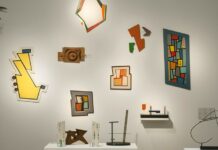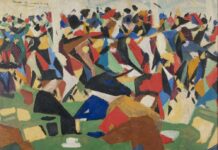All you need to know about Geometric Abstract Art…

5/5 (2)
In 1852, renowned writer Gustave Flaubert wrote a letter of what today seems like a premonition of what was about to happen back then in the world of art: “Perhaps beauty will become a feeling useless to humanity, and art [will become] something half-way between algebra and music.” Little time after this words were written down, meaning and representation would radically change the limits of visual perception and understanding through a series of artists and styles that would define the geometric abstract art movement and the different artists and facets that have represented it.
Cezanne and Seurat began to complete Flaubert’s prophecy, setting preconditions for abstract geometric art. Cezanne created his art on the strict and specific laws of geometry, treating nature through different figures like a cylinder, a sphere, a cone, everything seen through perspective, in a way in which every possible side of an object in the composition would be directed towards a central point. Cezanne attempted to go beyond nature and find the laws that composed it, hence his allegory of the divine which would later influence other painters as well. Seurat on the other hand, found harmony in an almost musical perception of reality, highlighting use of primary colours and simple shapes. He said “Art is Harmony. Harmony is the analogy of the contrary and of similar elements of tone, of colour and of line, considered according to their dominance and under the influence of light, in gay, calm or sad combinations”.

These two artists established the grounds for what was to come afterwards and we now recognize purely as fauvism and even expressionism which would be the transcendental basis of geometric abstraction. Geometric abstraction arrived after many decades of figurative painting where sensitive images of detailed landscapes, and portraits of pompous characters where featured in many paintings. This fundamental change consisted in the use of simple geometric figures (squares, circles, triangles) combined inside subjective compositions that lived inside surreal spaces. There was no reference to the real world, only fictional, utopic scenarios as if the goal was to say that painting is something that simply one does. It was born as a reaction towards the excess of subjectivity of the visual artists of previous movements in an attempt to distance themselves from the purely emotional. Abstract geometrical art tried to be precise, sticking to the rules of nature and science.


One of the pioneers and most emblematic artists of abstract geometric art was Kazimir Malevich, who founded the Suprematist movement. His purpose was the search of an absolute and pure expression, nonfigurative, unlike customary art. During his twenties Malevich established contact with Larionov, which opened the doors for him to new experiences and international relationships, getting to know fauvists, cubists and Italian futurists, playing a huge role on his own creations. His first experiments lead him to create this movement, based on an acute visual language which consisted of abstract geometric figures and neutral colours. He developed his work between 1912 and 1923. Along with his career, he created a series of numerous black and white geometric abstract art paintings. In 1915 he presented his most iconic and historically transcendental piece, called Black Square. Malevich promoted values of logic, mathematics and objectivity contrary to the subjective sensitive technicality of art established then. Claiming superiority in the abstract arts, this piece also rejected mainstream art of the moment and was considered the beginning of a new current, representing the death of conventional art, opening the doors to a new tradition of art.

Another transcendental exponent of modern abstract geometric art Piet Mondrian. He would be initiated in the art world by his uncle Frits, a landscape impressionist painter. The early youth days of Mondrian, influenced mostly by Amsterdam’s pictorial environment, included still life paintings, landscapes and academic studies. In order to survive, young Mondrian created copies of paintings that were exposed at the Rijksmuseum (Amsterdam) and drawing illustrations for books. Around 1901, he took on a trip to Spain to watch the bullfights, he was completely shocked and entered in a sort of mystical crisis that leads him to isolate himself in search of a new order, a new synthetic law. Between 1907 and 1908, he started getting in touch with fauvist artists before going to study cubism based on straight lines. During those years, he created a series of now-famous geometric abstract art paintings simply called “composition”.

In 1914 Mondrian went back to the Netherlands and in 1917 established a connection with Theo Van Doesburg with whom he created the “De Stijl” (The Style) magazine and its manifesto where we would write many theoretical articles of how art was supposed to be done. He created his first compositions of blue, yellow and red compact rectangles on a white background with primary colours and abstract geometric art with black and white. The purpose of his art was to re-establish the balance between man and nature. In 1920, due to disagreements with Van Doesburg Mondrian separated from the De Stijl movement and started getting in touch with the Bauhaus current and its players. Layer in his life he moved to New York, where we stopped using lines and started substituting them for rectangles and squared figures. Mondrian’s painting changed to be based completely on absolute thorough mathematics. He pretended to create a mix between art, matter and spirit to capture neo-plasticism (De Stijl) the universal harmony (using right angles and primary colours): an approach which goal was to discover the deep spiritual essence of reality and life. In the De Stijl movement, the principles that dominated artistic creation were always absolute abstraction, no reference to reality was allowed, and the language was restricted to lines and right angles, the three primary colours (blue, yellow and red) and the three non-primary colours, grey, white and black.

Famous geometric abstract art painter Van Doesburg, (co-founder of De Stijl) created a series of figurative studies to abstract them into geometric figures composed of lines, colourful rectangles and squares. He would later move on from the movement’s aesthetics by inserting lines of different lengths and widths and colours, this would be a cause of rupture with Mondrian inside the De Stijl since the artist was taking a different path to the one established in the manifesto. Van Doesburg lived a vivid political and educational life, establishing contact with different Bauhaus and constructivism artists, he even got involved in architecture and was a key promoter of the Dadaist movement all across Europe. Since the role of Van Doesburg was so essential to the De Stijl, the movement was not able to survive after his death, although many members stayed active and in touch with each other. Many of its original artists, especially Mondrian continued however to create artworks that would be heavily influenced by the current.

Bart Van der Leck, was another transcendental member of De Stijl, who despite having participated for a brief period of time, was extremely meaningful for the movement. Even though the artist refused to sign the manifesto, he created a series of geometrical abstract artworks in which his conception of geometrical painting and his colour palette had a determining influence on the creations of Piet Mondrian and Theo Van Doesburg. The artist would later still create realistic and figurative paintings and would sporadically continue experimenting with geometrical abstraction without sticking to the previously established rigid geometrical rules of De Stijl.

Geometric abstract art has had many different stages and facets across the history of art starting from the early XX century and expanding towards the present day. The influences of geometric abstract art could be seen along with different decades and continents, having also new waves in Latin-American art during the 60s and 70s. Its influence can still be identified in contemporary art and other movements of the XX century.
Cover image: Theo Van Doesburg, CompositionVIII_(The Cow), circa 1918, oil on canvas, Height: 37.5 cm (14.7 in); Width: 63.5 cm (25 in), Museum of Modern Art.













